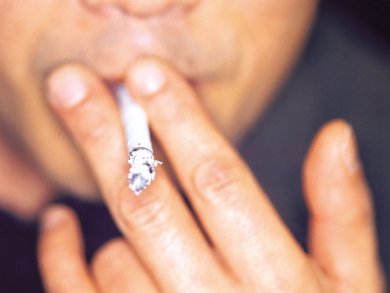Lingering Risk
Smokers primarily put their own health at risk with their habit, but their secondhand smoke puts others at risk too. Recent research has hinted that there are also risks from so-called “thirdhand smoke”, the residues left on and released from surfaces that have previously been exposed to tobacco smoke. The risk could linger for days or months after the smoker has left a room.
Yael Dubowski, of the Technion-Israel Institute of Technology, in Haifa, Israel, and colleagues have carried out laboratory tests that initially exposed materials mimicking clothing, carpeting and furnishings, to tobacco smoke and then exposed them to low-levels of ozone (55 parts per billion) and nitric oxide to simulate indoor air pollution. The team then analyzed the volatile and particulate matter that was produced and investigated the impact of ambient humidity on secondary organic aerosol (SOA) formation.
The team investigated surface reactions between nicotine, ozone and nitrogen oxides on model indoor surfaces comprising cellulose powder, cotton and paper. They observed SOA formation when adsorbed nicotine (a component of tobacco smoke) and gaseous ozone interact. The team used direct surface monitoring (Fourier transform infrared spectroscopy with attenuated total reflectance element (FTIR-ATR)) and particle counting to study the kinetics of this heterogeneous chemistry all within typical concentration ranges of indoor oxidants and relative humidity. They also examined the kind of chemistry that might occur near a person’s mouth in close proximity to a contaminated surface by employing nitric oxide levels within the range commonly measured in the exhaled breath of patients with asthma.
Exposure
The SOA varied in size distribution and number depending on humidity levels and the particular adsorbing material. They recorded SOA formation yields from the cellulose sorbed nicotine-ozone reaction of 1 and 2 % (wet or dry). In the presence of nitrogen oxide, SOA formation from nicotine-ozone reactions was indistinguishable from background concentrations. Major surface products included: cotinine and myosmine.
“Given the toxicity of some of the identified products and that small particles may contribute to adverse health effects, the present study indicates that exposure to thirdhand smoke ozonation products may pose additional health risks,” the team says. In the research paper’s supplementary information, the team describes a hypothetical situation in which such substances might lead to thirdhand exposure of infants or other people in close contact with contaminated materials and the putative health risks of such exposure. “Exposure to [ozonation products] can occur to babies crawling on the carpet, people napping on the sofa, or people eating food tainted by thirdhand smoke,” the team says.
They add that as well as inhalation, skin exposure and hand-to-mouth exposure must also be considered in the health equation. The half-life of cotinine (a major oxidation product) for instance could be as long as 5 days given the same ozone concentration as used in the tests. An active smoker could, in other words, leave a stark reminder of their presence and perhaps a lasting health legacy hours or even months after they leave a room.
Second- Versus Thirdhand Smoke
There is much controversy surrounding the notion of secondhand and thirdhand smoke. “Our work focuses on the chemical side,” says Dubowski. “It shows that constituents from cigarettes do sorb to various surfaces, and that nicotine may then re-emit back into the air or react with gaseous oxidants to generate products that may remain on the surface or re-emit back into the air.” He points out that, “Although we observed the formation of surface products and secondary aerosol that may have adverse health effect, we do believe that secondhand smoke is much more significant with regard to health impact than thirdhand smoke.”
As Dubowski suggests, the notion of thirdhand smoke putatively being hazardous to health is controversial. Research in the late 2000s alluded to the potential problem of this form of pollution but ongoing public and academic scrutiny has not yet resolved the issue. Dubowski’s work does provide a chemical basis for a possible risk but does not prove that the risk is substantial or otherwise. However, what is certain is that firsthand smoke is directly hazardous to the health of the smoker and recent evidence suggests that it could cause genetic damage almost the instant tobacco smoke is inhaled.
Instant Damage
Stephen Hecht of the University of Minnesota in Minneapolis and colleagues recently reported in Chemical Research in Toxicology how potentially carcinogenic polycyclic aromatic hydrocarbons (PAH) formed in tobacco smoke could be activated metabolically in the lungs. The researchers studied twelve smokers and used a unique approach involving a stable isotope derivative of D10-phenanthrene, the simplest PAH with a bay region, to track this metabolic process.
The researchers used gas chromatography-negative ion chemical ionization-tandem mass spectrometry and demonstrated the validity of a three-step pathway resulting in the formation of diol epoxides, which had previously been hypothesized. What was most remarkable about the results, however, was the rapidity with which the carcinogenic diol epoxides formed; plasma levels reached a maximum within 15 to 30 minutes. “Because PAH diol epoxides are mutagenic and carcinogenic, the results clearly demonstrate immediate negative health consequences of smoking, which should serve as a major warning to anyone contemplating initiating tobacco use,” the team concludes.
- Thirdhand Smoke: Heterogeneous Oxidation of Nicotine and Secondary Aerosol Formation in the Indoor Environment
L. M. Petrick, A. Svidovsky, Y. Dubowski,
Environ. Sci. Tech. 2011, 45 (1), 328-333.
DOI: 10.1021/es10206 - Immediate Consequences of Cigarette Smoking: Rapid Formation of Polycyclic Aromatic Hydrocarbon Diol Epoxides
Y. Zhong, S. G. Carmella, P. Upadhyaya, J. B. Hochalter, D. Rauch, et al.,
Chem. Res. Toxicol. 2011.
DOI: 10.1021/tx100345x
► Related News: Thirdhand Smoke — Big Health Hazard
Nicotine interacts with ozone, in indoor air, to form potentially toxic pollutants on surfaces like cellulose, cotton, and paper

